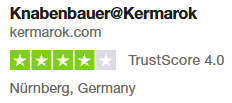HR Trends
Measuring the Company Pulse
Kerstin Knabenbauer • 14. Dezember 2022

ENGAGEMENT An overfloating amount of job postings increases the risk, that the employee changes employer more often.This has changed the landscape for employee surveys significantly and new digital solutions enable new ways of feedback systems and agile action plans in realtime.
Progressive employers who manage to hire the right people and to keep valuable resources on board, are aware of the power of daily communication to enhance engagement and they use different tools to ensure the dialogue with employees. With other words: They have discovered the power of measuring the pulse of their company.
This has changed the landscape for employee surveys significantly and new digital solutions enable new ways of feedback systems and agile action plans in flat organizations.
Surveys
Employee surveys is nothing new. The first surveys were introduced in the 1930ths by not organized employers in the U.S to avoid the establishing of trade unions in the organization. This is far away from progressive employers today, who use new digital tools including smart solutions and even artificial intelligence to ensure the daily pulse of an organization, to predict upcoming conflicts and to increase engagement and avoid employee turnover. Time have changed and today’s challenges on the labor market forces employers to take the step from long term improvement to daily dialogues and follow up to keep the staff in board.
The most common types of employee surveys measure a mix of employee opinion, satisfaction, culture and engagement. Companies normally put different focus on the outcome of the surveys, then to make sense, a survey should always be linked to the goals, strategies and the risks that have been identified by the management.
The Timing
Employee surveys are rolled out regularly and while more traditional oriented companies roll out the survey yearly or biyearly, leading HR organizations have found new ways to roll out the survey more often. Today, the most progressive employers even measure engagement and selected engagement drivers on daily basis.
There are different opinions about the best timing for the roll out. Some prefer to wait until the organization has come over turbulent times like organizational changes or merit increase processes to get “good engagement values”. This can be dangerous, and it is advisable not to step into that trap, then today, a disappointed employee will not wait for the next survey or one-to-one meeting if he or she finds a new job offer in the mailbox. The employer of choice sees this mindset as a part of the organizational life and is prepared to avoid fluctuation by daily communication with the staff.
The Solution
To give the staff a chance to communicate their concern in real time, the tools must be easy and uncomplicated to handle from both sides. The need for new digital tools is not only valid for global teams, where the manager must find ways to communicate remote. As the amount of remote worker increased rapidly during the pandemic, it got necessary for to offer new communication channels in addition to Zoom Meetings.
Digital solutions give managers crucial insight in how their whole organization is feeling and performing – from the holistic view down to the individual level. They monitor and compare the measurements of different teams, offices, or departments, and can easily identify strengths and roadblocks. They look into the survey responses behind each category to better understand the specifics of a temperature variation and they use this data to engage in richer dialogues.
The Role of the Manager
Digital solutions enable the communication and indicates the pulse of the company daily. The employee is treated as a customer and is given the same tools to show engagement and satisfaction as a customer who selects green and red smiles in the department store.
But how can the managers respond to such increasing stream of information? The success of all kinds of employee surveys are always based on action and improvement. Is there not a risk that the management creates expectations, that cannot be kept? The solution is closer than you might think.
Smart solutions help the manager with the communication and artificial intelligence help the management to predict future disengagement. But it is also important, that the manager steps down from traditional top-down perspective. The role of the manager is not to bring satisfaction to teams, the role of the manager is to enable engagement and satisfaction. Long term engagement can only be ensured if the manager uses his role as facilitator and enables the staff to take part of the improvement process directly. This improves engagement, because we know that responsibility, recognition, and performance are key engagement drivers.
For this reason, progressive digital systems do not stop with measuring engagement and satisfaction. To enable added value, it must also include tools for teamwork and improvement for managers and employees.


